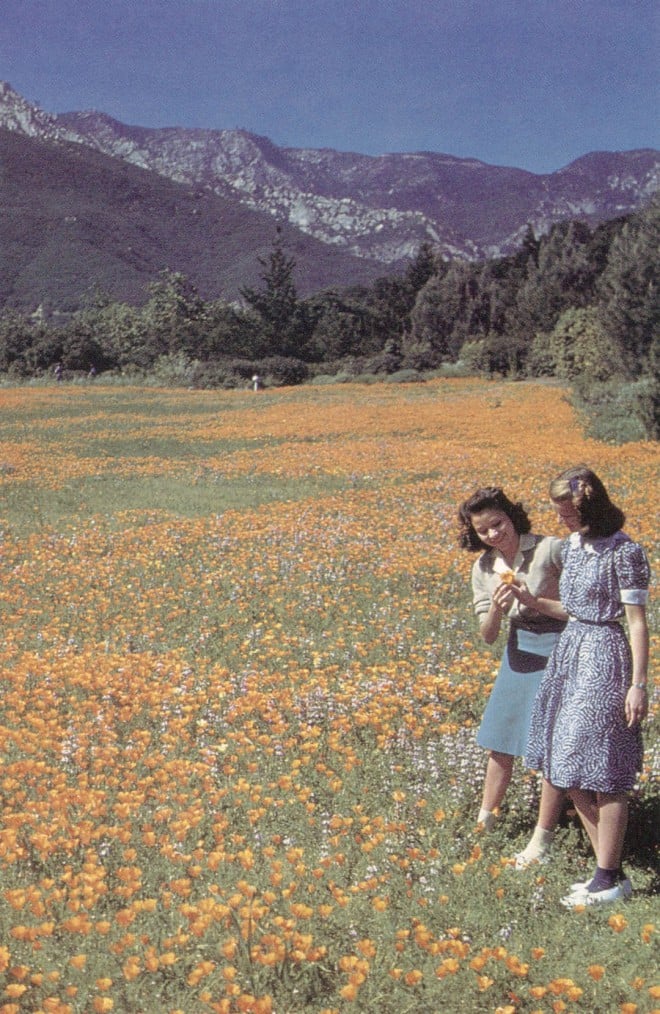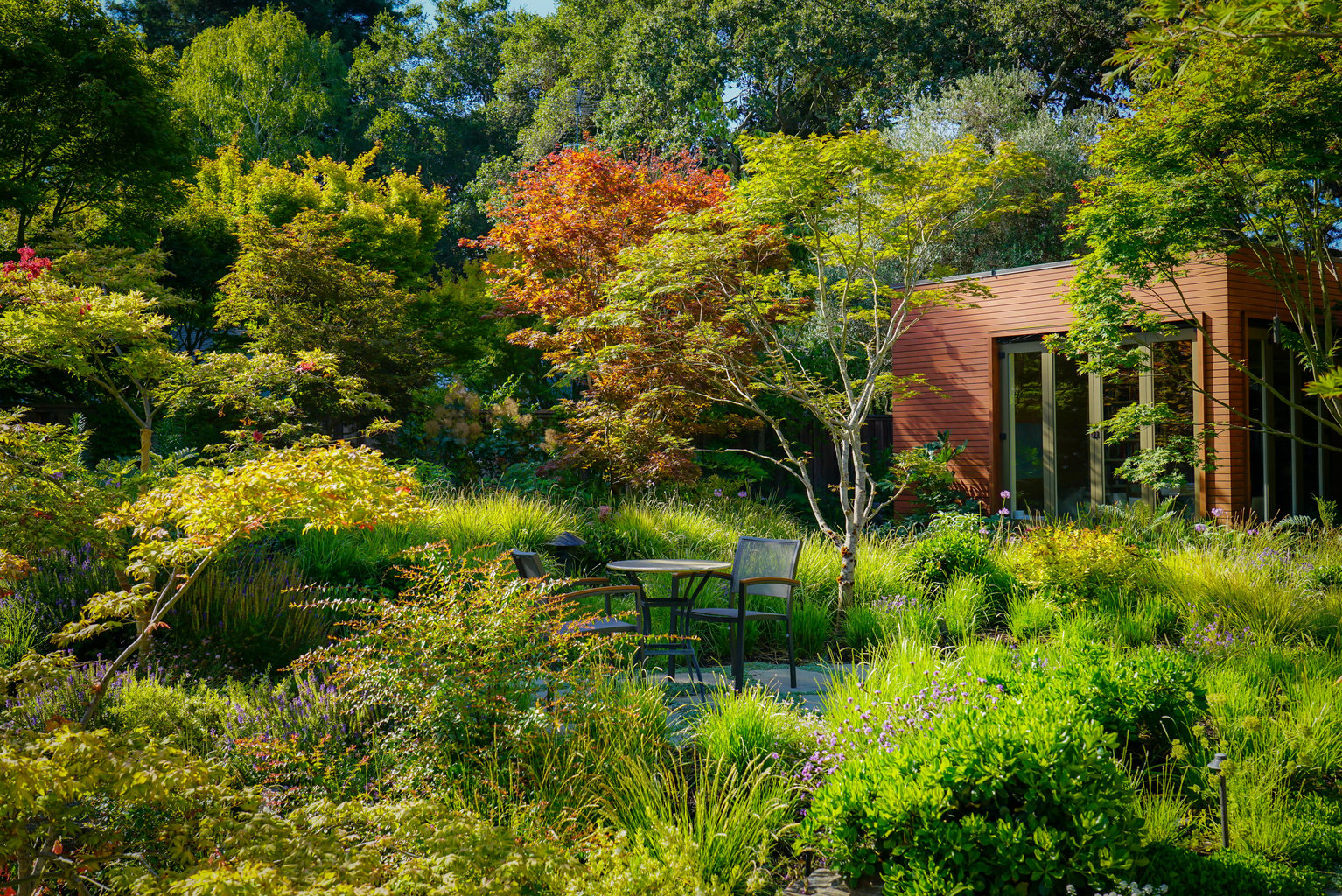
Santa Barbara Botanic Garden: Championing California Natives for 75 Years

Contributor

One must learn, to borrow Dr. Jepson’s delightful phrase, a plant’s range of tolerance, and learn also to widen it by skillful handling.
Ervanna Bissell, 1930
Throughout 2001, the Santa Barbara Botanic Garden has been celebrating its seventy-fifth birthday. Since its inception in 1926, the garden has been devoted to the display, study and conservation of California’s native flora. From its modest birth as a small memorial garden tucked away in a remote canyon, the garden has become a leader in fostering stewardship of the natural environment through its research and educational programs and its inspiring, naturalistic displays.

The Early Years
Although the exact sequence of events that led to the creation of a botanic garden in the Santa Barbara foothills is unclear, it is safe to say that the founders were motivated both by the desire to preserve the historic Mission Dam and to further the research of Dr Frederic Clements, a renowned plant ecologist. Having secured funding from the Carnegie Institution, Clements was searching Santa Barbara for sites to study the California flora when he became acquainted with Dr Elmer Bissell, a trustee at the Santa Barbara Museum of Natural History. After learning of impending development in Mission Canyon and of Clements’s work, Bissell convinced his friend Anna Dorinda Blaksley Bliss to purchase the fifteen-acre parcel that contained the dam. In 1926, the Blaksley Botanic Garden was launched as the “outdoor wing” of the museum.
A botanic garden devoted to California natives was a new and exciting idea in the 1920s. In fact, Rancho Santa Ana Botanic Garden, in Claremont, and Blaksley Botanic Garden were established within a few months of each other. A new aesthetic, more appropriate to our dry mediterranean climate, was emerging as the Victorian passion for all things exotic and gaudy faded. Although Dr Clements did not remain involved, his vision was central to shaping both the garden’s mission and arrangement. It was Clements who suggested organizing the garden into plant community groups such as redwood, big tree, oak-madrono, chaparral, desert, and prairie—a scheme still in effect today.
Dr Bissell and his wife, Ervanna, began to lay out trails and planting beds, run irrigation pipe, and construct buildings, transforming an oak-studded, weed-filled pasture into a public garden. Their goal was to artfully exhibit, in naturalistic settings, native plants that were suitable for use in private gardens, emphasizing water-conserving species. Botanists and nurserymen such as Carl Purdy, Theodore Payne, and Lester Rowntree, with whom they corresponded and purchased seeds and plants, supported their efforts.
After ten years of tireless, unpaid work and countless challenges, the garden had taken form, but the Bissells were exhausted. In 1934, Maunsell Van Rensselaer was hired to assist them. The Bissells soon retired and Van Rensselaer became director. He quickly realized that, although a beautiful garden had been created, other essential functions of a botanic garden were unfulfilled: missing were a master plan, planting records, wild-collected plant materials, and research and public education programs. As director, Van Rensselaer began to remedy these shortcomings by initiating the detailed records of planting, collecting, and propagation that are kept to this day.
Its endowment slashed by half during the Depression, the Blaksley Garden was in a precarious financial position in 1936. To enable the garden to solicit memberships and funding in its own right, it broke with the Museum of Natural History and incorporated as the Santa Barbara Botanic Garden in 1939. The garden survived thanks to the patronage of Anna Blaksley Bliss’s daughter, Mildred. Although her main residence was Dumbarton Oaks in Washington, DC, Mildred Bliss served as a trustee and promoted the Garden and its activities widely. Upon her recommendation, the renowned landscape architect, Beatrix Farrand (designer of the grounds at Dumbarton Oaks), joined the Advisory Council in 1938; her vision would have a great impact on the development of the garden.

Designing the Garden
Much of the Garden’s current design resulted from a master plan crafted by Santa Barbara landscape architect Lockwood de Forest, Jr, Beatrix Farrand, and others between 1937 and 1943. De Forest designed the information kiosk (modeled after one at Dumbarton Oaks) and several sandstone benches, and worked with EO Orpet to create the Desert Section. A new Library/Herbarium building, designed by architect Lutah Maria Riggs, was constructed in 1942. The siting of new buildings, the need for more parking, and the overall look of the garden were addressed in several revisions of the plan. Farrand and de Forest engaged in a lively discourse, with Farrand favoring a more formal design than that envisioned by de Forest. The compromise was a formal courtyard and entrance steps, counterbalanced by naturally curving paths linking these features with the focal point of the Blaksley Boulder.

By 1949, the garden had grown from fifteen to fifty acres through donations and purchases. During this period, the collections were expanded and diversified. The Ceanothus Section grew to nearly sixty taxa, ground was broken for the new Forest Section, and the Meadow underwent a series of transformations, from bermuda grass lawn to California poppies to beach strawberry (thousands of which were propagated each year). Some of the most famous views of the Meadow date from this era. With only two gardeners on staff, none of this would have been possible without thousands of hours of volunteer assistance.
Horticultural Contributions
Throughout its history, the garden staff has engaged in horticultural research, seeking to resolve the challenges of cultivating California natives, as well as selecting plants with exceptional landscape potential. When Van Rensselaer joined the staff, he began a research program on the propagation, cultivation, and horticultural merit of natives, with a particular emphasis on the genus Ceanothus. Results of his studies were published in Ceanothus, a book he co-authored with Howard McMinn in 1942. Santa Barbara’s diversity of street trees, the rich legacy of plant introductions by many fine local nurserymen, spurred Van Rensselaer’s keen interest in trees. After conducting an inventory for the city, he authored Trees of Santa Barbara in 1940. The Garden has published three editions of this book, with a fourth currently in preparation.

With the post-war economic and building boom, Californians became increasingly interested in gardening and sought guidance and inspiration from public gardens. To meet this need, the Home Garden was created on a small terrace above the Meadow. Designed by consulting landscape architect Ralph Cornell to illustrate the use of natives in a typical home setting, this low-maintenance garden showcased natives that were easy to obtain and grow. A 1958 Sunset magazine article about the Home Garden boosted the visibility of the project. Prompted by visitor interest, a second display soon followed featuring lawn substitutes and groundcovers.

Although the original Groundcover Display continues to thrive, the Home Garden was eventually abandoned after too many plants languished in the site’s heavy clay soil. The need for such a display remained, however, especially as California suffered through two drought cycles in the 1970s and 1980s. The Home Demonstration Garden, designed by landscape architect Ron Lutsko, was installed in 1990 around the former caretaker’s cottage. Taking advantage of several microclimates, the garden exhibits water-conserving species for sunny mixed borders, for the shady understory of mature oaks, as hedges and groundcovers, and for seasonal color in decorative pots.
Intent on keeping its living displays relevant and inspiring, garden staff embarked upon a new focus for the Meadow in the early 1980s. Eastern gardeners were discovering the beauty and versatility of ornamental grasses, but their use in California was limited. With a nod to Clements’s proposed prairie community, the Meadow became a celebration of California’s diverse and ecologically valuable grasslands. For almost twenty years, it has been an experimental growing ground, weaving together grasses and wildflowers for year-round color and texture.

Due to the robust post-war economy, the garden was able to hire Dara Emery, its first horticulturist and plant breeder. Emery propagated thousands of plants for the living collections and traveled throughout the state collecting seeds and cuttings. His interest in seed propagation led to extensive germination trials on a long list of native species. His exhaustive research results were first published in the leaflet, Seed Propagation of Native California Plants in 1964, then in a more comprehensive book of the same title in 1988. This invaluable reference is still the standard for professional and lay propagators.
Despite a burgeoning interest in landscaping with natives, the plants proved difficult to obtain. It was Dara’s idea to sell surplus plants intended for the living collections to the public at annual fall plant sales. He also helped establish the Garden Growers Nursery, staffed primarily with volunteers, as a venue for growing and selling natives and other drought-tolerant plants.
As natives became more widely used in gardens, enthusiasm for them was dampened by the temperamental behavior of a few species, tarnishing their reputation in general. To redress this, Emery and other horticulturists began to breed and select cultivars with outstanding ornamental features and wider adaptability to typical garden conditions. This objective was in keeping with one of the garden’s earliest goals, as stated by Ervanna Bissell in 1931: “to use plants native to wild places and adapt them to cultivated surroundings….to find a plant’s range of tolerance and carefully increase it.” Dara’s most notable introductions were Heuchera ‘Canyon Pink’ and H. ‘Canyon Delight’, Iris ‘Canyon Snow’, and Ceanothus ‘Wheeler Canyon’. All told, the Garden has introduced twenty-six cultivars to date, many of which came from the California and Baja California Channel Islands, a result of extensive garden research on these islands.
With the Earth’s precious resources increasingly imperiled, the role of public gardens is more vital than ever. The Santa Barbara Botanic Garden will continue to champion responsible gardening, conservation of California’s native flora and magnificent natural landscapes, and a deeper appreciation and understanding of all plant life.
[sidebar]
If you should like to visit…
The Santa Barbara Botanic Garden, located in Mission Canyon, is open daily from 9 am to 5 pm; admission is $5 for adults, $2 for children and seniors. For information about programs, membership, or volunteer opportunities, contact the office at 1212 Mission Canyon Road, Santa Barbara, CA 93105 or phone 805/682-4726.
[/sidebar]
Share:
Social Media
Garden Futurist Podcast
Most Popular
Videos
Topics
Related Posts

Low Maintenance Gardens – Better for Pollinators and People
Autumn 2022 “I come out every day. It’s therapy, my meditation.” Janet’s young garden transformed from overgrown, invasive plants to mostly natives. The dailiness of

Invasive Plants Are Still Being Sold: Preventing Noxious Weeds in Your Landscape
Autumn 2022 With so many beautiful ornamental plant species and cultivars throughout California and the Pacific Northwest, how do you decide which ones to include

Garden Design in Steppe with Transforming Landscapes with Garden Futurist Emmanuel Didier
Summer 2022 Listen to full Garden Futurist: Episode XVII podcast here. Emmanuel Didier, Principal and Creative Director at Didier Design Studio is a leading figure

Seslerias: Versatile Groundcover Meadow Grasses
Summer 2022 Without question, the most beautiful and versatile of all the groundcover meadow grasses are the moor grasses (Sesleria). Moor grasses tick off all










Responses